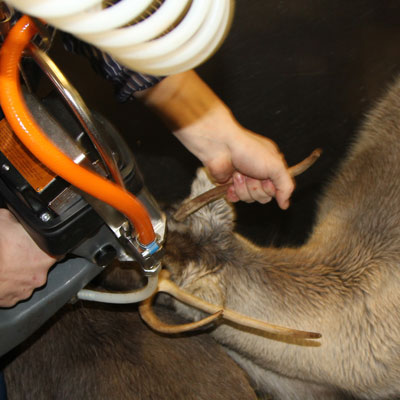Captive bolt stunner
The captive bolt stunner uses a penetrating bolt which penetrates through the animal’s skull and into the brain. Damage from the bolt and the force of the blow against the skull is transmitted through the brain, leading to severe concussion and heavy bleeding and resulting in the animal being stunned, i.e. rendered unconscious.
To achieve unconsciousness, the bolt and the force of the shot must affect the brain stem, which is a continuation of the spinal cord up into the head. The brain stem is the centre for a range of vital functions such as respiration and circulation, and it also acts as a “switching centre” for signals between the cerebrum and the cerebellum.
The bolt itself causes direct damage to the front parts of the brain, but to achieve effective stunning (i.e. achieving and maintaining unconsciousness until exsanguination and death) the shot also has to cause a massive bleed at the base of the brain. This means that the blow to the forehead causes concussion, resulting in the lower and rear parts of the brain colliding against the inside of the skull and the arteries entering the brain rupturing, causing the blood pressure to the brain to drop. In this way, therefore, these injuries can cause safe stunning. The captive bolt stunner uses a penetrating bolt which penetrates through the animal’s skull and into the brain.

Photograph: Mats Westman.
A knowledge of reindeer anatomy and the position of the brain inside the skull are a basic prerequisite for correct positioning of the shot. The age, sex and head shape of the animal may also be of significance to where the shot is to be positioned. The aiming of the bolt against the skull is also important in order to generate as much force as possible in the shot. The bolt must be fired perpendicular to the skull to avoid the bolt slipping and/or penetrating obliquely through the frontal bone, thereby reducing the impact force on the brain and increasing the risk of not achieving the intended effect.
If the force of the bolt does not cause sufficient damage, there is a risk of the animal not being stunned sufficiently, i.e. showing signs of consciousness and awareness. In this case, it is important to re-stun the animal quickly and also to have access to a reserve stunning method. Appropriate reserve equipment and reserve instruments must be available at the slaughter location so that they can be used in emergencies. It is important for all instruments to be readily accessible if a reserve method has to be used.